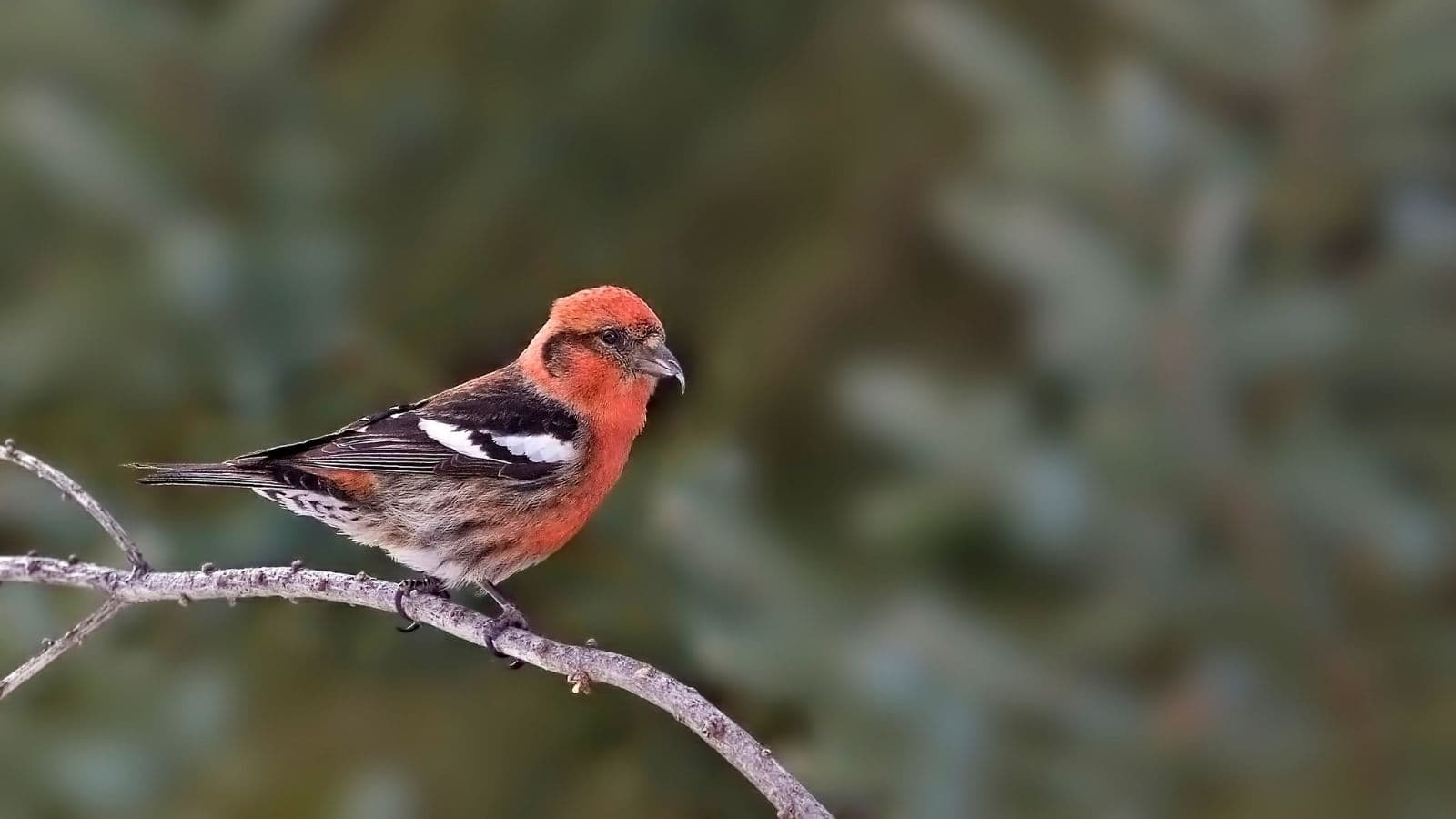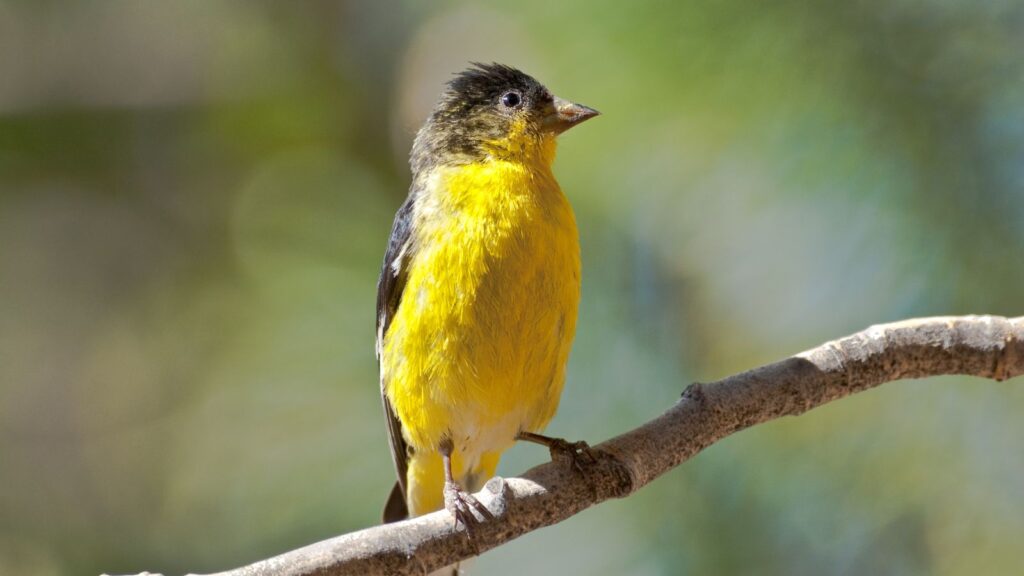The state of Alabama provides tremendous bird-watching opportunities for the intrepid enthusiast. You can explore over 42,000 acres of protected wilderness, including eleven national parks, four national forests, and eight official birding trails.
However, you don’t need to hit the trails to see some of the over 400 species of birds that live in this state. Sometimes, you don’t need to look any further than the view outside your own window.
Some of the most fascinating and beautiful birds are those from the finch family. From amazing seed-cracking abilities and unique songs to gymnastic prowess, these are some of the most amazing birds in the Nebraskan skies.
Let’s look at some of the most common and uncommon species and how you can attract them right to your own backyard feeders.
House Finch

- Scientific Name: Haemorhous mexicanus
- Length: 5.1-5.5 in (13-14 cm)
- Weight: 0.6-0.9 oz (16-27 g)
- Wingspan: 7.9-9.8 in (20-25 cm)
Would you buy a Hollywood Finch? In the 1930s, pet shop owners in New York sold the birds under that glamorous name as caged pets. These birds were actually a Mexican species called the Mexican Bullfinch renamed by salesmen to capitalize on America’s fascination with the movie industry.
However, the sale of the birds was illegal. So, in 1940, in a bid to evade the law, their captors released them back to the wild right there in New York, rather than taking them home to Mexico. They began breeding and are now common all over the United States.
The House Finch is a year-round Alabama resident. The male is a rosy little bird with a red head and breast. Red tinges are sometimes also visible amongst the grey and brown plumage of the rest of his body. The female has a more subtle brown and grey coloration. However, the intensity and shade of red will vary depending on the individual’s diet.
You can find the birds in woodlands and around buildings, parks, and yards. You can also attract them to your backyard birdfeeder with a healthy supply of sunflower seeds.
American Goldfinch

- Scientific Name: Spinus tristis
- Length: 4.3-5.1 in (11-13 cm)
- Weight: 0.4-0.7 oz (11-20 g)
- Wingspan: 7.5-8.7 in (19-22 cm)
If you’ve ever seen a bright yellow American Goldfinch in the fresh green background of spring, you know what a stunningly beautiful sight it is. Both the males and females carry this stunning, yellow hue during the breeding season.
However, that color does not remain year-round. The American Goldfinch is the only species of finch that molts twice a year. The first time is in the spring when it takes on its bright yellow hue in preparation for mating.
The second time is in the fall, when it reverts to a duller, brownish color, making it a bit harder to distinguish from other finches.
Goldfinches are attracted to all kinds of feeders, but for your best shot at catching a glimpse of the gold, provide lots of sunflower or nyjer seeds.
Also, listen for this species’ unique pre-flight call. As they get ready to take off, they emit a call that sounds like the words potato chip.
Pine Siskin

- Scientific Name: Spinus pinus
- Length: 4.3-5.5 in (11-14 cm)
- Weight: 0.4-0.6 oz (12-18 g)
- Wingspan: 7.1-8.7 in (18-22 cm)
Both the male and female Pine Siskin display grey and brown plumage highlighted by patches of bright yellow. These small birds are especially prepared for the cold night air. They have the unique and very useful ability to raise their metabolic rate up to 40% higher than other birds their size which helps them keep warm even in the coldest winds.
These birds are also quite the gymnasts. Frequently foraging for food high in trees, they’re often spotted hanging upside down in an effort to reach the seeds they want.
If you want to view these birds, hang your feeder, filled with Nyjer and sunflower seeds, near conifers and other thick vegetation that will persist through the winter. Make sure there are plenty of branches for them to perch on.
But be cautious. They travel and feed in flocks so you might wind up with a whole yard full of visitors.
Purple Finch

- Scientific Name: Haemorhous purpureus
- Length: 4.7-6.3 in (12-16 cm)
- Weight: 0.6-1.1 oz (18-32 g)
- Wingspan: 8.7-10.2 in (22-26 cm)
This bird’s name is a little bit deceiving as they aren’t exactly purple at all. The breeding male’s head and breast take on a beautiful red-pink color, with tinges throughout their grey and brown bodies. The female has a white and brown dappled head and breast.
These birds are amazing mimics. Although they have their own distinct calls, they are also capable of imitating the calls of a number of other birds, including Barn Swallows, Brown-headed Cowbirds, and American Goldfinches.
Although the Purple Finch only spends the winter in Alabama, it’s a beautiful bird, worth catching a glimpse of when you can. Like many other finches, it’s attracted to sunflower seeds and sometimes suet.
Red Crossbill

- Scientific Name: Loxia curvirostra
- Length: 7.9 in (20 cm)
- Weight: 1.4 – 19 oz (40 – 53 g)
- Wingspan: 10.5 – 11 in (27 – 29 cm)
If you ever see a Red Crossbill, you’ll know it. These birds have a distinctive bill with the upper and lower mandibles crossing past each other, creating a powerful tool for opening the tough seeds they feed on.
The breeding males also have a distinctive red body, interrupted only by their grey wings and tails. The females show a hint of yellow on the head and breast, and brown and grey wings and tail.
There have been so many variants and cross-breedings, however, that scientists are left a little bit puzzled as to how to classify the many different types that have been recorded.
You’re unlikely to find one of these attractive birds in your own garden, however. Currently, the only place known to be reliable for Red Crossbill sightings in Alabama is Coleman Lake in the Talladega Mountains.
But if there’s any chance for them to turn up in more suburban areas, it’s likely to be in areas with plenty of apple slices, peanuts, safflower, suet, and millet.
Evening Grosbeak

- Scientific Name: Coccothraustes vespertinus
- Length: 6.3-7.1 in (16-18 cm)
- Weight: 1.9-2.6 oz (53-74 g)
- Wingspan: 11.8-14.2 in (30-36 cm)
This bird’s rather poetic name came from early settlers who were under the impression that the birds only came out to sing at dusk. They do sing by day, as well, but their song is very simple compared to other finches.
However, what they lack in musical creativity, they make up for in sheer beak strength. They are known for their powerful beaks which can crack open seeds that are just too tough for other birds.
As with many species, the males have a more distinctive coloration. Besides their distinctive conical, cream-colored beak, look also for the dark head with a yellow brow and breast, punctuated by a sharply contrasting white and black wing. The female has just a hint of yellow on her neck and her white breast with a grey head and back and black and white wings.
Your best bet for attracting Evening Grosbeaks to your yard is a birdfeeder full of sunflower seeds. However, you’re not likely to see them, anyway, unless you live in their frequent dwelling region of North Alabama.
Accidental Species
Several species of finch are only in Alabama because they wandered off of their regular route or are leftover from a virtually vanished population. These birds are especially rare in the Alabama wilderness but are still worth the effort to the lucky few who manage to spot one.
Lesser Goldfinch

- Scientific Name: Spinus psaltria
- Length: 3.5-4.3 in (9-11 cm)
- Weight: 0.3-0.4 oz (8-11.5 g)
- Wingspan: 5.9-7.9 in (15-20 cm)
You’d be hard-pressed to miss the breeding male Lesser Goldfinch. With its yellow feathers, dark wings, black cap, and black or dappled back. It stands out just as beautifully as its larger relative, the American Goldfinch. The females are pale yellow with grey and black dappled wings.
It’s very rare to see this species in Alabama, and the few sightings that have been reported have been in the City of Mobile.
Lesser Goldfinches usually forage in flocks. You can find them near streams or forest edges. If you want any chance of seeing one in your yard, keep your feeder full of nyger seeds. As well, the color yellow tends to attract them. Selecting a yellow feeder or tying a bit of ribbon to your feeding station may bring the Lesser Goldfinch to your yard.
Common Redpoll

- Scientific Name: Acanthis flammea
- Length: 4.7-5.5 in (12-14 cm)
- Weight: 0.4-0.7 oz (11-20 g)
- Wingspan: 7.5-8.7 in (19-22 cm)
If you spot one of these pretty little perching birds, know that you’re looking at a creature very far from home.
These birds are most common in countries that border the Arctic Circle, but they do make their way into more southern regions of North America, sometimes reaching as far south as Kansas. However, they have very rarely been seen as far south as Alabama, with the last sighting being in 2013.
Look for a bright red cap, a bright yellow bill and a pinkish breast highlighting a white and grey body on the breeding male. The female sports a red cap and a brown, grey, and white body.
If there’s any chance of seeing one in Alabama, watch particularly around birch trees, as the seeds of this tree are the Common Redpoll’s favorite.
White-Winged Crossbill

- Scientific Name: Loxia leucoptera
- Length: 5.9-6.7 in (15-17 cm)
- Weight: 0.8-0.9 oz (24-26 g)
- Wingspan: 10.2-11.0 in (26-28 cm)
There have been no White-Winged Crossbill sightings recorded in Alabama since 2011. However, maybe you’ll be the next to see one.
Look for a red head and breast with black wings and tails that stand out with gleaming patches of white feathers. This is the breeding male. The female couldn’t look more different with her grey, brown, and yellow-tinged pattern.
They have a respectable appetite, putting away up to 3000 seeds from spruce and tamarack trees per day.
They are also distinctive from other birds in that they don’t have a specific breeding season. While many birds stick to spring as the best time to lay their eggs, White-Winged Crossbills have been known to breed in any month of the year so long as there is food available.
Final Thoughts
If you’re on the lookout for finches in Alabama, keep a special eye out for a little guy with a spotted chest that resembles the pattern on a loon’s back. This guy has the rather tasty name of Spice Finch. He’s also sometimes known as the Scaly Breasted Munia or the Nutmeg Mannikin.
So rare are these little birds that they’re not even indexed in the Cornell Lab of Ornithology’s extensive database of birds, which focuses mainly on North American Species.
These birds are native to Asia. However, they are sold as pets and, when they escape their cages, they will settle in other parts of the world where the climate is suitable. So, if you see one, be sure to take pictures and report your sighting to your local birding association. They’ll want to know.
But finches are far from the only bird family in this southern state. To find out about the wide range of bird species in Alabama, check out our complete guide to the Birds of Alabama.

